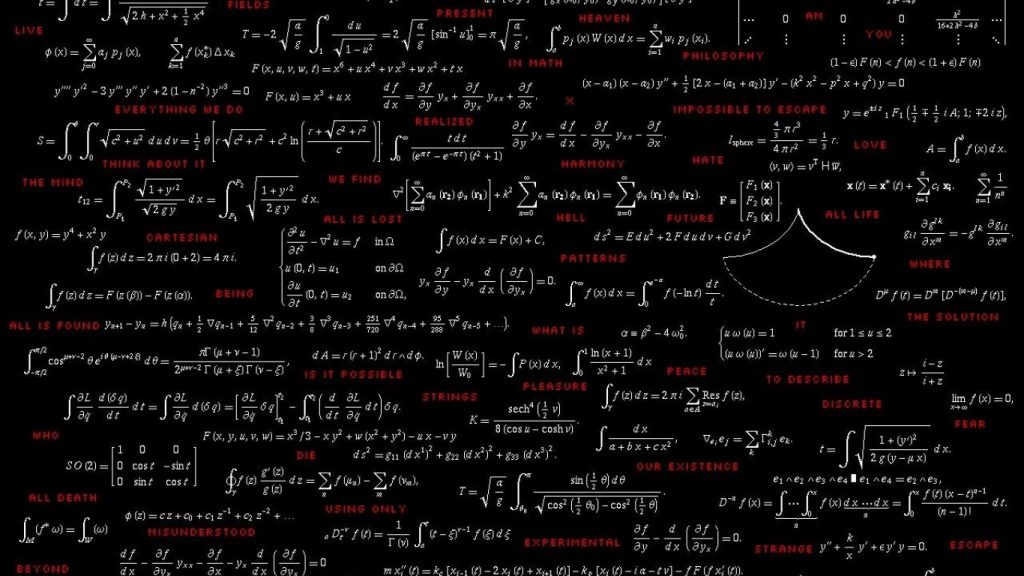Calculus is a subject loved by some and feared by many. But what is Calculus? The simplest definition is: the study of how things change. Calculus can be used to make a model of the velocity at which an object moves, how it accelerates, and even its jerk. Calculus can also be used for optimization, like maximizing the volume of a container or minimizing the cost of production of a product. Calculus can be used to calculate the area of a curve, or to find the volume of solids with atypical cross-sections. Calculus has two main branches that are opposite to each other. Just as addition is to subtraction, Differential Calculus is to Integral Calculus. So how did we ever get this particular domain of human knowledge? Actually, it was the work of two men, working independently on mathematical explanations and independently discovering Calculus. This is their story.

Sir Isaac Newton, born January 4, 1643 in Lincolnshire, England, was a physicist, mathematician, philosopher, and the culminating figure of the scientific revolution of the seventeenth century. He laid the foundations for modern physics in optics, created the three laws of motion that led to the law of universal gravitation, and led the English Royal Society, one of the first scientific communities in Early Modern Europe.1 Gottfried Leibniz, born July 1, 1646 in Leipzig, Germany, was a philosopher, mathematician, and political adviser. He was recognized for his contribution to Metaphysics and Logic.2 What these two men have in common is that they both discovered calculus, even though they never met each other.
During the time of its discovery, Calculus was considered an invention, a completely new branch of mathematics. However, Calculus had been in development throughout the centuries of mathematical evolution. It was just a matter of time until somebody managed to incorporate all the tools and discoveries into a single discipline with a specific notation. Great mathematicians like Archimides, Ptolemy, Diophantus, Fibonacci, Kepler, and Cavalieri make contributions to basic arithmetic, geometry, and trigonometry that were fundamental for later developments and discoveries in higher mathematics. Kepler developed the “Sum of the Radii,” which is a rude kind of integration; and he considered solids to be composed of infinitely small disks put together, which is an idea used on integration. Cavalieri’s Principle greatly contributed to the idea of Integration, as well as Descartes’ and Fermat’s work in Analytic Geometry.3
Ever since the discovery of Calculus, there has been a debate concerning who discovered it first, Newton or Leibniz. Immediately after Leibniz’s publication of Nova Methodus pro Maximis et Minimis in 1684, accusations were made that his work was influenced by earlier works of Newton’s. Newton claimed he had made the same discoveries twenty years earlier but had not yet published them, and Leibniz had copied his (Newton’s) own method, which he called the method of fluxions. In an attempt to settle the dispute, Leibniz appealed the quarrel to the English Royal Society. However, Newton was the president of this society, and appointed a committee formed of his friends to investigate the allegations. The Royal Society subsequently officially accused Leibniz of plagiarism.4 But did Leibniz actually managed to plagiarize Newtons’ work?
Newton discovered Calculus using a geometric approach, when working on his theory of fluxions. This theory consists of the fundamentals of instantaneous change, a basic component of Calculus. He then connected it to the study of infinite series of his predecessor, John Wallis, to create Calculus. But the term Calculus was introduced by Leibniz some years later, when he published his work mentioned above. As opposed to Newton, Leibniz used an analytical approach when discovering Calculus. Therefore it is unreasonable to say that Leibniz plagiarized Newton’s work. Their differences in approach suggests that their discoveries were simultaneous but independent. In addition to his development of Calculus, Leibniz created a mathematical notation to be used in this mathematical field that has become standard for the discipline.5

In sociological theory, simultaneous but independent discoveries or inventions are common. This phenomenon suggests the possibility that society is destined to make certain technological advances and discoveries, and that such innovations become inevitable as related pieces of knowledge accumulate.6 So this situation between Newton and Leibniz might be just another one of these cases, because the development in mathematics in that period of time provided the circumstances for both of these mathematicians to put together this knowledge to discover Calculus. Despite their individual success, Newton and Leibniz recognized the previous developments by many other mathematicians that allowed them to discover Calculus. Newton himself said regarding his own success “If I have seen a little further than others it is because I have stood on the shoulders of giants.”7
The discovery of Calculus was then a feat done by two brilliant mathematicians, independently and by using different approaches. Leibniz did not plagiarize Newton’s work, but supported it unknowingly.
- Encyclopedia Britannica, July 2017, s.v. “Sir Isaac Newton,” by Richard S. Westfall. ↵
- Encyclopedia Britannica, August 2017, s.v. “Gottfried Wilhelm Leibniz,” by Yvon Belaval. ↵
- Susan M. Bautista, Calculus: man’s invention or destined discovery? (San Antonio: St. Mary’s University, 1998), 5-6. ↵
- Susan M. Bautista, Calculus: man’s invention or destined discovery? (San Antonio: St. Mary’s University, 1998), 7-9. ↵
- Susan M. Bautista, Calculus: man’s invention or destined discovery? (San Antonio: St. Mary’s University, 1998), 11-12. ↵
- Susan M. Bautista, Calculus: man’s invention or destined discovery? (San Antonio: St. Mary’s University, 1998), 13. ↵
- Rouse Ball, A Short Account of the History of Mathematics (New York: Dover Publications, 2012), 93. ↵



40 comments
Kenneth Gilley
What an interesting article! It is amazing that Isaac Newton and Gottfried Leibniz discovered calculus individually, yet simultaneously. It is a shame that Leibniz was accused of having plagiarized Newton’s work. Truly, calculus is one of the greatest inventions humankind has ever created. I wonder if Newton or Leibniz ever dreamed what the impact of their discovery would one day be.
Michael Hinojosa
Even though I still am and never was a huge fan of math I was always interested in knowing how all of these topics and calculations came to fruition; calculus especially as that was my least favorite class in high school, causing me to spend multiple nights wondering why this topic was ever created. And after reading this article I got my answer! It’s kind of funny to me that even though this was a two man job only one person was remembered: Newton. I hope one day more people know about Leibniz and how much he helped create this subject.
Diamond Davidson
This was very interesting to read because I love math class, but once I go into AP Calculus I was terrified of taking. I was a math genius from pre-K to 11garde, but once I was put into AP Calculus I wasn’t doing so good how I wanted to, but it’s weird and was hard for mw to understand how did people actually come up with “math/calculus.” Now I understand why they have many ways to do problems because 2 different people came a with calculus in a different way. I just believe they should have got more recognition for coming up with something brilliant like Calculus. Overall, this was a good article to read.
Ryan Estes
This was a very interesting article! In high school I was always afraid to take Calculus because I knew it was a difficult subject. I like learning about how things were invented. I found it interesting that Leibniz and Newton never met each other, yet they were able to use everything that was discovered about mathematics in the past to develop a new discipline. I may sound ignorant when I say this, but I don’t think I knew there were two branches of calculus. As a final statement, I thought the introduction to this article was really well-written. Great job!
Danielle Slaughter
While I most definitely cannot say that I am particularly fond of math, especially Calculus, I do love science and discovery. Funnily enough, I encounter the same issue Newton and Leibniz ran into as a writer. I can come up with the most amazing idea for a story, only to research for it later and find out someone has already done it or something very similar, and I have to scrap it. In any case, the saying goes, “Great minds think alike”. Newton and Leibniz both “discovered” Calculus in their own rights, using different methods as you stated. This goes to show that these men were geniuses, and I do agree that perhaps it was destiny.
Octaviano Huron
The birth of Calculus is a true coincidence. Sir Isaac Newton and Gottfried Leibniz were geniuses in their own rights, and both are honorably recognized as founders of advanced mathematics. From personal experience, I believe that Calculus is an intimidating subject that is often difficult to understand. But, I also believe that this subject contributes to how the world can be explained in terms of change.
Antonio Coffee
I am personally not a fan of math, it is easily my least favorite subject. This article was interesting to me though. I like to see how people interact and the idea that two people discovered the same thing independently and simultaneously is incredibly interesting. I have only heard good things about Newton before, but it makes sense that he would abuse his power to ensure that he got credit. It is what most people would do in a similar situation, even though it is wrong.
Luke Lopez
This was a very interesting article on the history of Calculus, and who discovered it. Isaac Newton, and Gottfried Leibniz were both the two main people that were credited with discovering Calculus, despite never meeting each other. Newton used a geometrical approach when he discovered Calculus, and Leibniz used an analytical approach when he discovered Calculus. Overall, this was a great article on Isaac Newton, Gottfried Leibniz, and their discovery of Calculus.
Nathan Hartley
Having already taken a calculus class, I already knew some of the information mentioned in this article, but I didn’t know the entire history of how calculus was created. I liked hearing about their rivalry in my class, but I am happy to see someone wrote about it to educate people who may not know how calculus was made.
Damian Jennings
I was never a fan of math but I took interest in reading this article to gather information on the history and the concepts presented by the author. One man I am very familiar with was Newton, but a new name surfaced, Leibniz; both shaped and constructed the foundation of calculus. It saddens me to be so familiar with Newton and not Leibniz, they should both be credited properly.